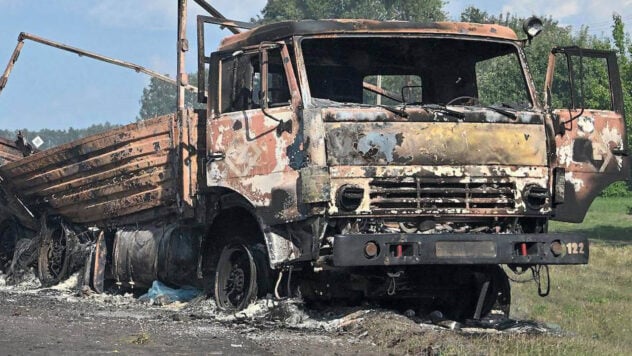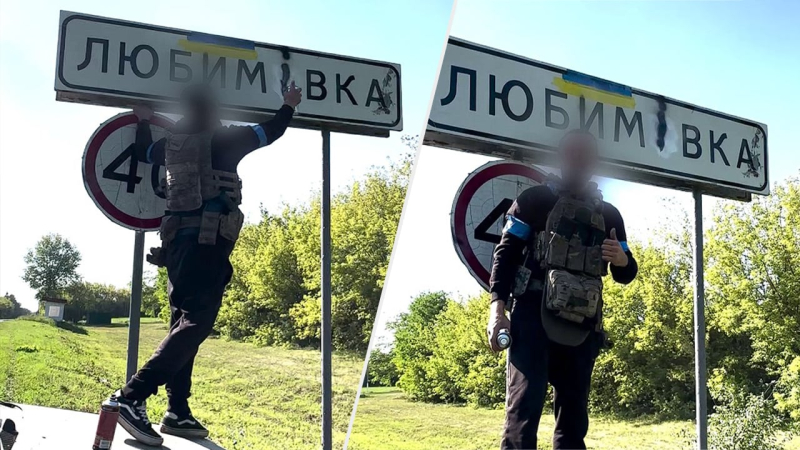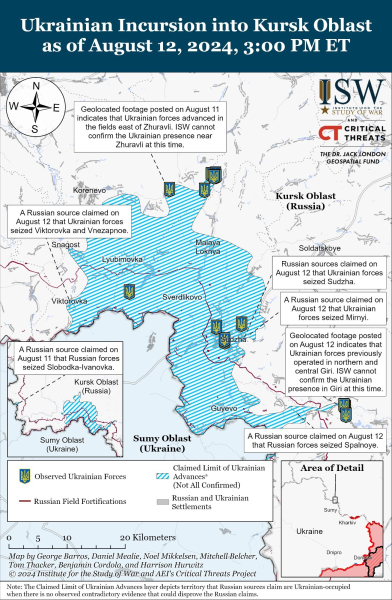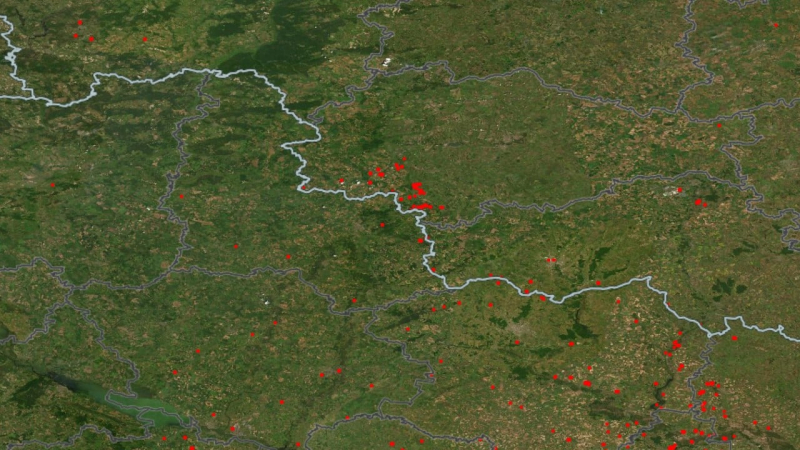
The operation of Ukrainian troops in the Russian Kursk region began on the morning of August 6.
The Ukrainian side has begun to officially comment on its involvement in the intensification of hostilities in the Kursk region and the presence of the Ukrainian Armed Forces on the territory of the Russian Federation.
At the same time, some information is still coming into the open, which allows us to find out in a certain way what the situation is in the Kursk region of the Russian Federation, where the Ukrainian Armed Forces operation is continuing, to build a chronology of events, and also, thanks to analysts and additional tools, to understand where the hostilities are taking place in the Kursk region.
Now watching
You can see a map of hostilities and find out what is happening in the Kursk region on ICTV Fakty.
- What is happening in the Kursk region: a chronology of events
- 6 August
- August 7
- August 8
- August 9
- August 10
- August 11
- August 12
- August 13
- Military Operations Map – Kursk Oblast
What's happening in Kursk Oblast: a chronology of events
August 6
The operation in Kursk Oblast began on the morning of Tuesday, August 6. Ukrainian troops crossed the border with the Russian Federation, directing their advance to the Sudzhansky and Korenevsky districts of Kursk Oblast.
Due to the unpreparedness of the Russian side — insufficient number of experienced personnel, a general shortage of forces and resources, and a lack of intelligence — the advance of the Ukrainian military achieved additional success, as it allowed them to take control of a number of settlements and neutralize many Russians.
The Russian Federation reported that about 300 Ukrainian soldiers, 11 tanks and more than 20 armored combat vehicles entered Kursk region. The advance of the Ukrainian Armed Forces took place in the direction of the settlements of Oleshnya, Sudzha and Nikolayevo-Daryino.
In response to the advance of the Ukrainian military, the Russian army tried to return fire, in particular, attacking the Sumy region. On the evening of August 6, a ballistic missile, two drones and a helicopter were destroyed over the Sumy region.
Later, photos of two destroyed tanks of the Russian occupation army appeared.
August 7
According to journalist Dan Sabb, who deals with defense and security issues at The Guardian, as of the morning of August 7, Ukrainian troops had advanced about 9.5 km. At the same time, there were reports of the Ukrainian Armed Forces being close to the city of Sudzha.
Since the Ukrainian side does not officially comment on information about the movement of Ukrainian troops, or deliberately provides it with a delay, like the Deepstate portal, the so-called Russian war correspondents began to actively disseminate information. According to their information, as of August 7, Sudzha was operationally surrounded.
Only on this day, August 7, Russian dictator Vladimir Putin decided to convene the Security Council of the Russian Federation. During his speech, he called the fighting in Kursk a “large-scale provocation”.
Also on Wednesday, photos and videos appeared of Russian troops (according to various sources, these are border guards and conscripts) massively surrendering to the Armed Forces of Ukraine. Videos appeared online where several Ukrainian soldiers take Russians prisoner, who significantly outnumber them. Later, video interviews with prisoners emerged, who were identified and thus confirmed to be Russian citizens.
Subsequently, reports began to appear that within 24 hours, Ukrainian troops were able to advance into the city of Korenevo, which is 20 km from the Russian-Ukrainian border.
Also in the evening in the Kursk region, a car in which Russian war correspondent Yevgeny Poddubny was traveling was damaged by an FPV drone strike. As it later became known, Poddubny survived, but received multiple injuries and burns, after which he was transported to Moscow for treatment.
August 8
As journalists from the Russian publication Agency assessed, Ukrainian troops were able to break through two lines of defense of the Russian army, which were being built in the Kursk region. This cost the Russians about 15 billion rubles.
Telegram channels reported that shooting battles continued around Sudzha in the morning.
Also, according to observers, the advance of the Ukrainian Armed Forces extended to a distance of 35 km beyond the Ukrainian border.
August 9
Already on Friday, August 9, the total combat zone expanded to 600 square kilometers, Radio Liberty observers indicate.
In the morning, footage also appeared of a broken, broken column of the Russian Army, which was moving along the Glukhov-Kursk highway near the village of Oktyabrskoye, in the Rylsky district.
Video footage of the aftermath of the attack on the convoy shows at least 14 damaged military trucks. The bodies of Russian soldiers can also be seen in the backs of military vehicles, which, according to some observers, indicates that the Russians did not even have time to jump out of the vehicle at the moment the attack took place.
Estimates of Russian losses after this strike vary. According to NEXTA, Russian losses after this strike could reach up to 500 people.
— Each of the trucks can carry up to 35 fully equipped troops. The video shows 14 destroyed vehicles, suggesting the Russian army may have lost between 200 and 490 soldiers overnight in the strike. It would be one of the largest mass casualties for the Russian army since the start of the full-scale war, the report says.
Other observers are hesitant to give specific figures, and some have more conservative estimates. For example, Ukrainian journalist and war correspondent Yuriy Butusov points out that the video shows “many dozens of Russian soldiers” who were destroyed.
Following the broken column of the Russian military, it became known that in parallel, Russian troops sent other reinforcements to the combat zone in the Kursk region.
At the same time, Igor Korpunkov, the mayor of the city of Kurchatov, where the Kursk nuclear power plant is located, said that battles are taking place tens of kilometers from the plant. According to Russian media reports, Rosatom temporarily reduced the number of personnel at nuclear power plants, and all units under construction were de-energized.
In turn, the acting governor of the Kursk region, Alexey Smirnov, said that a fire started in one of the districts as a result of a Ukrainian UAV hitting a transformer substation. He did not provide evidence of Ukraine's involvement in the strike. According to him, after the accident, Kurchatov, as well as part of the Kurchatovsky, Oktyabrsky, Velikosoldatsky, Oboyansky and Belovsky districts, remained without power.
Another Russian Mi-8 helicopter was also destroyed by an FPV drone. According to volunteer and activist Sergei Sternenko, the helicopter was damaged in the tail section.
August 10
On the night of August 10, the largest counter-terrorism operation (CTO) regime in history was introduced in Russia. It was established in three regions at once due to the advance of Ukrainian troops. We are talking about the counter-terrorist operation regime in the Kursk, Bryansk and Belgorod regions, as reported by the National Anti-Terrorist Committee (NAC) and the administrations of Russian regions.
The Russian NAC says that such a measure is connected with Ukraine's attempt to “destabilize the situation” in three border regions of Russia.
Russian media write that in terms of the number of people involved (about 4 million people), the current counter-terrorist operation regime has become the largest in the history of Russia.
Videos and photos of new captured Russians continuing to arrive in parallel, who are being sent by car, probably to Ukrainian territory.
Also on Saturday, footage emerged of a group of Ukrainian fighters entering the village of Poroz, in the Belgorod region of the Russian Federation. Analysts and military observers point out that this step may be a way to disperse Russian troops, but at the time of publication of this material, the final situation remains unclear.
August 11
On the night of August 11, the Ukrainian Defense Forces probably advanced towards the Belovsky District of the Kursk Region, which is south of the Sudzhansky District. At least, this information was initially reported by Russian pro-war bloggers. This information was later confirmed by the head of the Belovsky District, Nikolai Volobuyev.
According to Volobuyev, the advance of Ukrainian troops has caused “confusion and panic” among the region's residents, but he assured that “the situation is stable”.
The situation remains unclear regarding other districts of the Kursk Region, although a number of sources, in particular Russian ones, have reported breakthroughs by the Ukrainian Armed Forces in various directions. This information was not confirmed by any photo or video evidence.
At the same time, a mass evacuation of the local population is taking place in Kursk region. Thus, according to the Russian Ministry of Emergency Situations, more than 76 thousand residents of the region were evacuated.
It is also noteworthy that although Ukraine does not confirm its involvement in the operation in Kursk region, at the same time, on August 11, the Commander-in-Chief of the Armed Forces of Ukraine Oleksandr Syrskyi published a photo in which he is standing next to a map, and in the note itself on the Telegram channel he wrote: “Continuing the operation”.
August 12
President of Ukraine Volodymyr Zelenskyi acknowledged the involvement of the Armed Forces of Ukraine in the operation in the Kursk region of the Russian Federation.
— We see how Russia is actually moving under Putin: 24 years ago there was the Kursk disaster — the symbolic beginning of his reign. Now we can see what is the end for him. And Kursk too. The disaster of his war. This always happens to those who despise people and any rules, — the President of Ukraine said.
Commander-in-Chief of the Armed Forces of Ukraine Oleksandr Syrsky said that about 1 thousand square kilometers in the Kursk region are under Ukraine's control.
According to the president, we are talking about the areas from which the Russian army launched attacks on the Sumy region. As of today and since June 1, this is already almost 2.1 thousand shellings of the territory of the Ukrainian region.
The head of state emphasized that the operations of the Armed Forces of Ukraine in the Kursk region are purely a matter of security for Ukraine and the liberation of the border area from Russian troops.
Russian propagandists have already announced 28 captured settlements in the Kursk region. At the same time, analysts of the Deep State project report 44 settlements.
In particular, it became known about the removal of the Russian flag in the village of Dar'ino, Sudzhansky District, Kursk Region, Russian Federation.
August 13
The Ukrainian Armed Forces' operation in the Kursk region poses a real dilemma for Russian dictator Vladimir Putin, US President Joe Biden has commented on for the first time.
— This creates a real dilemma for Putin. We are in direct and constant contact with the Ukrainians. That's all I can say about it while the offensive continues, — Joe Biden said in a comment to foreign journalists.
This was the first official comment by US President Joe Biden after the start of the operation of the Armed Forces of Ukraine in the Kursk region.
On the afternoon of August 13, President Volodymyr Zelensky said that 74 settlements in the Kursk region of Russia are under Ukraine's control.
As noted by the Commander-in-Chief of the Armed Forces of Ukraine Oleksandr Syrsky, Ukrainian troops have advanced in certain directions from 1 to 3 km. According to him, 40 square kilometers of the territory of the Kursk region have been taken under control.
Among such settlements is Lyubimovka in the Kursk region, which is under the control of Ukraine. The settlement was cleared of Russian servicemen, as stated by the Black Swan unit of the 225th separate assault battalion.

Photo: Black Swan Unit 225th Assault Brigade
Russia has to transfer troops to the Kursk region from Kaliningrad and the temporarily occupied territories of Ukraine. In particular, from Crimea, Kherson and Zaporozhye regions.
Thus, Russian marines from the 810th Marine Brigade of the Russian Black Sea Fleet were transferred to the Kursk region, as stated by the occupation governor of Sevastopol Mikhail Razvozhaev.
According to President Volodymyr Zelensky, Ukraine is expanding the area of combat operations in the Kursk region of Russia.
The head of state noted that hundreds of Russian soldiers have already surrendered. He promised that they will all receive humane treatment, which they did not receive even in their own Russian army. The president also thanked the Ukrainian defenders for replenishing the exchange fund.
Map of combat operations in the Kursk region
Today, the exact situation in the Russian Kursk region is unknown. The vast majority of information to clarify the situation on the ground comes from Russian sources, while the Ukrainian side effectively maintains a regime of information silence, not disclosing data on its actions, since this could create a danger for the defenders of the Defense Forces.
Due to such limitations with data in open sources, one of the main sources of information are the resources of the enemy, namely pro-Russian war correspondents and bloggers who actively publish data on the battles in the Kursk region. In addition, from time to time, information appears in open sources that provides additional insight into the events in the Kursk region, which, ultimately, provides insight into the events on the ground.
Considering the security situation, one of the most authoritative portals that regularly records events on the combat map, Deepstate, refused to clarify the current information, since this could threaten the safety of the Ukrainian military. Instead, the portal decided to provide data with a certain time lag.
In turn, analysts from the Institute for the Study of War (ISW) created their own map, which outlined their vision of the military actions in the Kursk region of the Russian Federation.
ISW observers write that the Kremlin's announcement of a counter-terrorism operation in three regions of the Russian Federation, and not martial law or martial law, indicates that the Russian authorities want to downplay the scale of the Ukrainian advance in the Kursk region and prevent “panic or domestic backlash, demonstrating the Kremlin's reluctance to take more radical measures in response to the situation”.
Analysts note that some pro-war Russian bloggers have suggested that the Kremlin “officially declare war on Ukraine” and “criticized the Kremlin for not declaring martial law instead of a counter-terrorist operation”.
According to ISW, declaring martial law would, in particular, allow the Russian authorities to take “more decisive measures, such as banning rallies and demonstrations, introducing a curfew, and organizing the production of defense products for the army”.

Map of military operations as of August 12, 2024. Photo: Institute for the Study of War (ISW)
Of particular note are NASA's FIRMS heat maps, which record high temperature data via satellites during civilian times and help track fire outbreaks. During a war, this data additionally helps to determine in which places exactly the fighting is taking place, since FIRMS satellites record the locations of explosions and fires after landing.
Thus, according to FIRMS data for the last 24 hours, fighting continues over an area of about 1.5 thousand km.

Photo: FIRMS
Recall that in parallel with the fighting in the Kursk region, the self-proclaimed President of Belarus Alexander Lukashenko ordered to strengthen the military presence in the Gomel and Mozyr tactical directions bordering the Kiev and Chernihiv regions.
Head of the Center for Countering Disinformation National Security and Defense Council (NSDC) Andriy Kovalenko has already stated that the accumulation of weapons from Belarus to the border area is an attempt to help Putin and divert the attention of the Ukrainian command to that direction.

